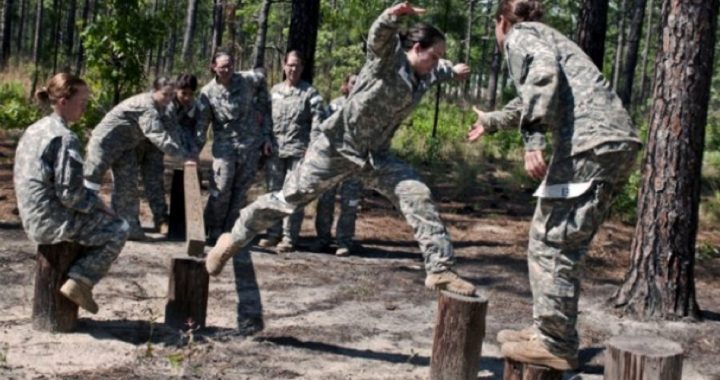
By a close 32-30 vote, the House Armed Services Committee approved a bill on April 27 that would require women to register for the draft. Amazingly, the bill’s sponsor, Representative Duncan Hunter (R-Calif.) voted against the measure, which he introduced only to prompt a discussion about the Pentagon’s decision in December to eliminate restrictions against women serving in combat roles in the military.
Hunter probably never thought that a majority of members of the committee would actually vote to approve the bill, H.R. 4478. The California congressman, a former Marine who served three combat tours in Iraq and Afghanistan, even gave his bill an ominous name that should have discouraged its passage: the “Draft America’s Daughters Act of 2016.” The House Armed Services Committee has 36 Republican members and 27 Democrats so the measure passed with Republican support. A roll call is not available as we write.
Defense Secretary Ash Carter announced last December that, beginning in January 2016, all military occupations and positions would be open to women, without exception. Carter admitted openly that this was a first in U.S. military history. “[Women will] be allowed to drive tanks, fire mortars and lead infantry soldiers into combat,” Carter stated when making the announcement. “They’ll be able to serve as Army Rangers and Green Berets, Navy SEALs, Marine Corps infantry, Air Force parajumpers, and everything else that was previously open only to men.”
A Defense Department website article noted on December 3:
In a memorandum to the secretaries of all military departments and others, Carter directed the military services to open all military occupational specialties to women 30 days from today — a waiting period required by law — and by that date to provide updated implementation plans for integrating women into the positions now open to them.
The Marine Corps had asked for a partial exemption from the new requirements in areas that included infantry, machine gunner, fire support reconnaissance, and others, but Carter stated: “We are a joint force and I have decided to make a decision which applies to the entire force.”
Hunter introduced his legislation on February 3, and it contained language noting that it would become effective 90 days after the bill’s enactment or “the date on which the Secretary of Defense certifies to Congress that all Combat Arms Military Occupational Specialties are open to qualified female candidates.”
On March 10, Carter released a statement announcing final plans for all branches of the military and the U.S. Special Operations Command to open up all combat jobs to women. He authorized the military to begin integrating female combat soldiers “right away.” He said in his statement:
When I announced my decision back in December to open all career fields to qualified women, I emphasized that the implementation of this change must be handled the right way, because the combat effectiveness of the world’s finest fighting force is paramount. Having reviewed their exceptionally thorough work, I am pleased all of the services developed plans that will effectively carry out this change and make us even better in the future.
Since there is no history in our nation of sending women into combat, Hunter undoubtedly thought that his bill would do only what he intended — prompt discussion — not be approved by a committee in which Republicans are in the majority. In 2013, National Geographic News reported that only eight other nations allow women to serve in combat roles: Australia, Canada, Denmark, France, Germany, Israel, New Zealand, and Norway. India joined their ranks in 2016.
During debate on his measure, Hunter presented the stark reality of what the consequences of the draft are. “A draft is there to put bodies on the front lines to take the hill,” he said. “The draft is there to get more people to rip the enemies’ throats out and kill them.”
However, another committee member, Representative Jackie Speier (D-Calif.) said she supported the bill — in the name of “equality.” “I actually think if we want equality in this country, if we want women to be treated precisely like men are treated and that they should not be discriminated against, we should be willing to support a universal conscription,” she said.
It is hard to imagine that the authors of our Bill of Rights envisioned the right to be sent home in a body bag as an unalienable right.
NBC News reported that Hunter’s amendment was part of a defense policy bill that authorizes defense spending for the fiscal year that begins October 1. The committee passed the spending bill by a 60-2 vote the day after approving Hunter’s amendment.
As was noted in an article posted by The New American on February 4, a 1,000-page study from last fall by the Marine Corps Ground Combat Element Integrated Task Force (GCEITF) concluded that gender-integrated units made up of males and females did not perform as well as all-male units. The report noted that these units suffered a higher injury rate than all-male units.
The debate over whether or not to include women in combat has been ongoing for decades. As far back as 1987, retired Army Brigadier General Andrew J. Gatsis, wrote an article for The New American’s print edition entitled “Woman at War” that discussed the many pitfalls of such a policy. After the Pentagon announced in December that all combat roles would soon be opened to women, The New American posted the article online.
In that article, Gatsis observed: “Although this effort [to put women in combat roles] is funneled through the Women’s Movement, it emanates from and is controlled by a power-seeking group whose objective is to reduce the combat effectiveness of our military establishment and create a unisex society.”
Although the push to send women into combat (and, concurrently, to make them subject to the draft) is just now coming to a head, the forces behind that move were already in place back in the 1980s when Gatsis wrote his article. The general quoted from a February 1982 memorandum sent by Deputy Defense Secretary Frank Carlucci to the service secretaries with the following demand: “I want you to identify specifically the military career paths, officer and enlisted, which are closed or in any way restricted to women by combat limitations you have in place.”
Throughout his lengthy article, Gatsis provided many examples of why placing women in combat units was detrimental to military effectiveness. Citing just one such example, he wrote:
In 1966 the defense minister of Israel, Moshe Dayan, spent a day with my battalion in Vietnam. He told me that Israeli women were placed in combat in the 1948 War of Independence, but were withdrawn permanently from the front three weeks later because the mixed-sex units suffered such heavy casualties….
Even this one-time experience with women in a low intensity conflict was enough for the Israelis, for they have taken women completely out of the combat roles. Colonel Dalia Raz, formally Chief of the Israeli Army-Women Contingent, said, “The most equal job is combat, but we don’t want it because of what happened to our women in the last war in which they fought.”
A reading of the entire article provides a very convincing argument against sending women into combat.
Representative Hunter was evidently overly optimistic about the common sense of most members of the House Armed Services Committee when he introduced his amendment to the defense spending authorization bill as a way to stimulate discussion about the pros and cons of sending women into combat. It can be hoped that better sense will prevail when the measure comes up for a vote before the entire House.
Related articles:
Congress Urged to Include Women in Draft Registration
Defense Secretary Panetta to Lift Ban on Women in Combat
GOP Presidential Candidates Cave in on Women in Combat



